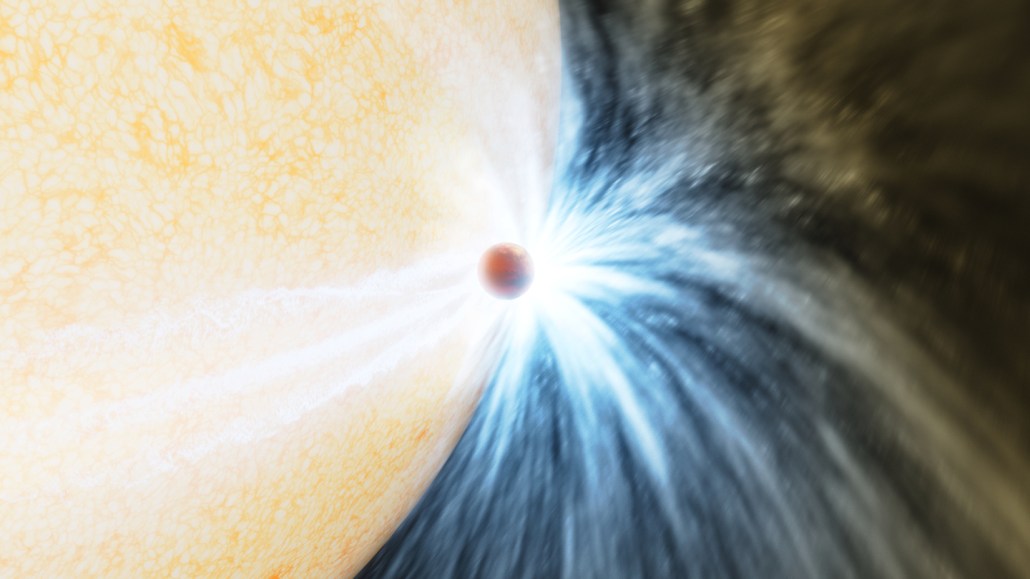In a first, telescopes have caught a star eating a planet
A dusty belch in space was all that remained after the star’s planetary snack

Dust blasts into space as a star (illustrated) swallows a planet about 10 times as massive as Jupiter.
K. Miller and R. Hurt/IPAC/Caltech
Share this:
- Share via email (Opens in new window) Email
- Click to share on Facebook (Opens in new window) Facebook
- Click to share on X (Opens in new window) X
- Click to share on Pinterest (Opens in new window) Pinterest
- Click to share on Reddit (Opens in new window) Reddit
- Share to Google Classroom (Opens in new window) Google Classroom
- Click to print (Opens in new window) Print
For the first time, scientists have spotted a star eating a planet. The planet was probably about 10 times the mass of Jupiter and orbited a star 10,000 light-years away. Its demise gave off a burst of light captured by telescopes on the ground and in space.
Researchers shared the discovery May 3 in Nature. This dramatic end to a distant exoplanet offers a glimpse of Earth’s future — since our own planet, like so many others, will eventually be swallowed up by its star.
Stars were long suspected to eat their own planets, says Kishalay De. But no one knew how often this happened. “It was certainly exciting to realize we had found one,” De says. He’s an astrophysicist at MIT who led the research.
De didn’t set out to find a planet-eating star. He was originally hunting for binary stars. These are pairs of stars that orbit each other. De was using data from the Palomar Observatory in California to look for spots in the sky that got brighter fast. Such surges of light can come from two stars getting close enough together for one to suck matter from the other.
One event from 2020 stood out to De. A spot of light in the sky quickly got about 100 times as bright as it was before. It could have been the result of two stars merging. But a second look by NASA’s NEOWISE space telescope suggested this wasn’t the case.
NEOWISE looks at infrared wavelengths of light. Its observations revealed the total amount of energy released in the flash that Palomar saw. And if two stars had merged, they would have released 1,000 times as much energy as was in the flash.
Plus, if two stars had merged to produce the flash, that region of space would have been filled with hot plasma. Instead, the area around the flash was full of chilly dust.
This hinted that if the flash did come from two objects smashing into each other, they weren’t both stars. One of them was probably a giant planet. As the star chowed down on the planet, a stream of cold dust sailed away like cosmic breadcrumbs. “I was indeed surprised when we connected the dots together,” De says.
Planet-devouring stars are probably pretty common in the universe, says Smadar Naoz. But until now, astronomers have seen only signs of stars preparing to snack on planets — or debris that could have been left over from a stellar meal.
Naoz is an astrophysicist at the University of California, Los Angeles. She was not involved in the study. But she has thought about the ways that stars might gobble up planets.
A young star might consume a planet that wanders too close. Think of that as a stellar lunch, Naoz says. A dying star, on the other hand, will swell up to become a supersized star called a red giant. In the process, that star might swallow up a planet in its orbit. That’s more like a cosmic dinner.
The planet-eating star in this study is turning into a red giant. But it’s still early in its transformation. “I would say it’s early supper,” Naoz says.
Our sun will evolve into a red giant in about 5 billion years. As it balloons in size, the star will consume Earth. But “Earth is much smaller than Jupiter,” De notes. So the effects of Earth’s doom will not be as spectacular as the flare seen in this study.
Finding Earth-like planets getting eaten “will be challenging,” De says. “But we are actively working on ideas to identify them.”







